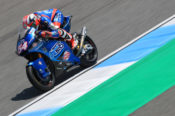Boxing Clever
BMW let us loose in Portugal on the all-new R1250GS with ShiftCam Technology.
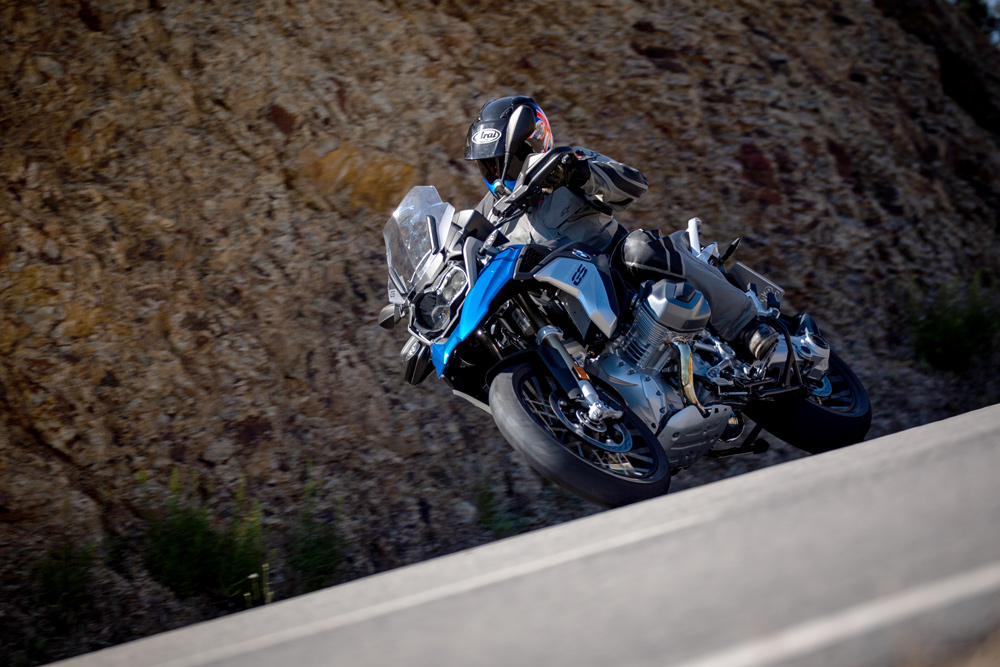
In creating the new R1250GS just launched for 2019, BMW has had to address the single most difficult task confronting any manufacturer, which is to improve on a bike already established as the reference point in its category. Making the best better still is even trickier if the company in question actually set the class benchmark in the first place by itself inventing that kind of bike some years ago. And even more so if the model in question is responsible for a substantial part of its entire annual sales volume.
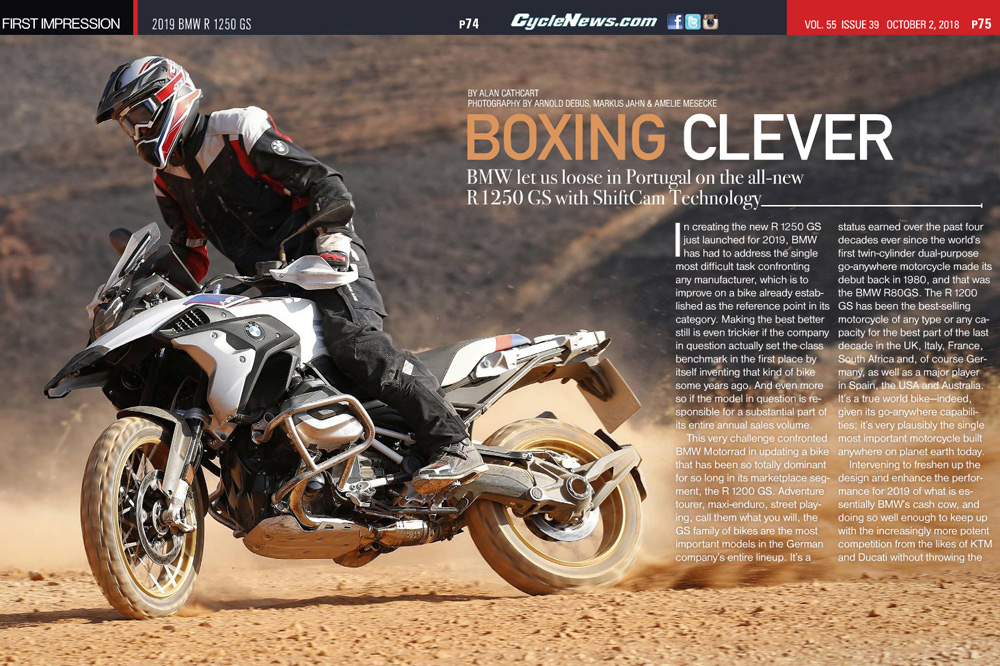
PHOTOGRAPHY BY ARNOLD DEBUS, MARKUS JAHN & AMELIE MESECKE
Click here to read this in the Cycle News Digital Edition Magazine.
This very challenge confronted BMW Motorrad in updating a bike that has been so totally dominant for so long in its marketplace segment, the R1200GS. Adventure tourer, maxi-enduro, street playing, call them what you will, the GS family of bikes are the most important models in the German company’s entire lineup. It’s a status earned over the past four decades ever since the world’s first twin-cylinder dual-purpose go-anywhere motorcycle made its debut back in 1980, and that was the BMW R80GS. The R1200GS has been the best-selling motorcycle of any type or any capacity for the best part of the last decade in the UK, Italy, France, South Africa and, of course Germany, as well as a major player in Spain, the USA and Australia. It’s a true world bike—indeed, given its go-anywhere capabilities; it’s very plausibly the single most important motorcycle built anywhere on planet earth today.
Intervening to freshen up the design and enhance the performance for 2019 of what is essentially BMW’s cash cow, and doing so well enough to keep up with the increasingly more potent competition from the likes of KTM and Ducati without throwing the baby out with the bathwater, was very definitely a major challenge for BMW’s R&D team headed by project leader Jochen Beck. So that’s surely one reason that the new-for-2019 R1250GS doesn’t look a whole lot different than the outgoing R1200GS that’s been in production since 2004, receiving three major updates along the way while building an ever more loyal band of customers for a bike whose versatility is legendary. The R1250GS has some big shoes to fill.
So while making detail changes to the aesthetics, like the snazzy new cam covers on the Boxer engine or the crisp new paint schemes, the BMW R&D team’s big focus has been on further improving the engine’s performance and usability.
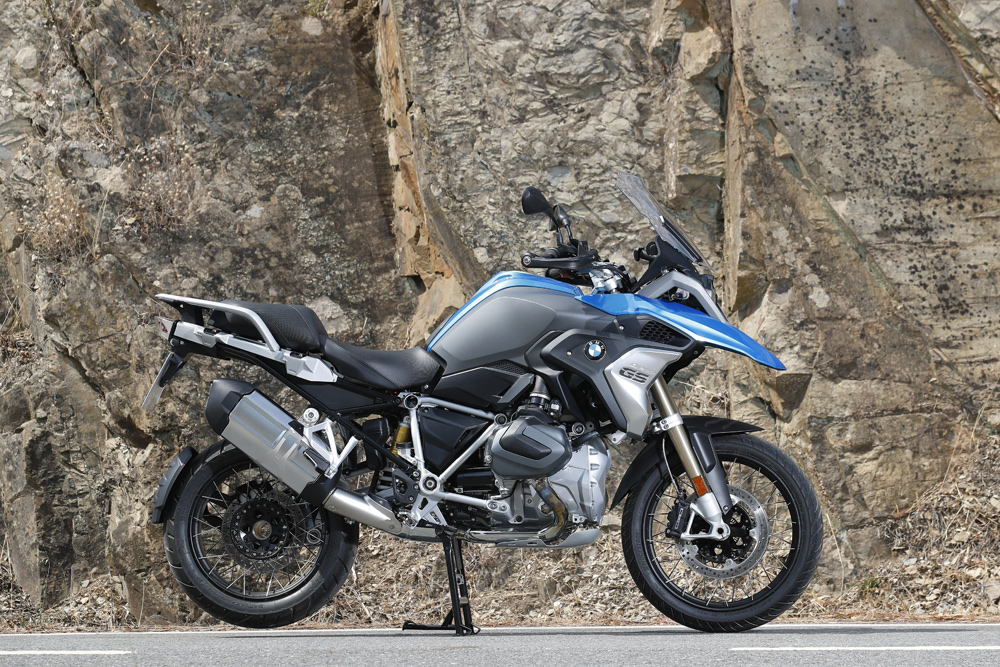
BMW achieved this with the radically innovative ShiftCam system (see sidebar) combining both variable valve timing and differential valve lift, all in the same package. This is a key ingredient of the heavily revised version of BMW’s trademark air/water-cooled eight-valve Boxer-twin engine powering the R1250GS, the result of three years of development. Capacity has been increased to 1254cc from the R1200GS motor’s 1170cc, via revised dimensions of 102.5 x 76mm, against the R1200GS’s 101 x 73mm. Compression ratio has been bumped up to 12.5:1 but the engine is now fitted with dual knock sensors to permit the use of low-grade fuel in remote corners of the earth. This new engine delivers 136 bhp/100 kW at 7750 rpm, with maximum torque of 143 Nm at 6250 rpm (versus 125 bhp/92 kW at 7750 rpm, and 125 Nm at 6500 rpm, previously). So with a seven-percent capacity increase, the bored and stroked new Boxer engine offers nine-percent more horsepower and 14 percent more torque than its predecessor. Even though the R1250GS motor doesn’t rival a 160 bhp KTM 1290 Super Adventure in terms of absolute performance, the smooth and practically cuddly way it delivers the extra power and torque more than compensates for that.
The chance to find out for myself how great a difference in real world terms this made on the new bike compared to the old one, came on the first day of the global press launch via a grueling 140-mile Portuguese day trip in 34-degree temperatures aboard the new GS, in both on-road and off-road guises. To begin with, climbing aboard the new GS seemed like slipping on a brand-new pair of your favorite shoes—everything felt pretty much the same as on the outgoing model, save for the addition as stock of the large 6.5-inch full-color Connectivity TFT dash previously available only as an option.
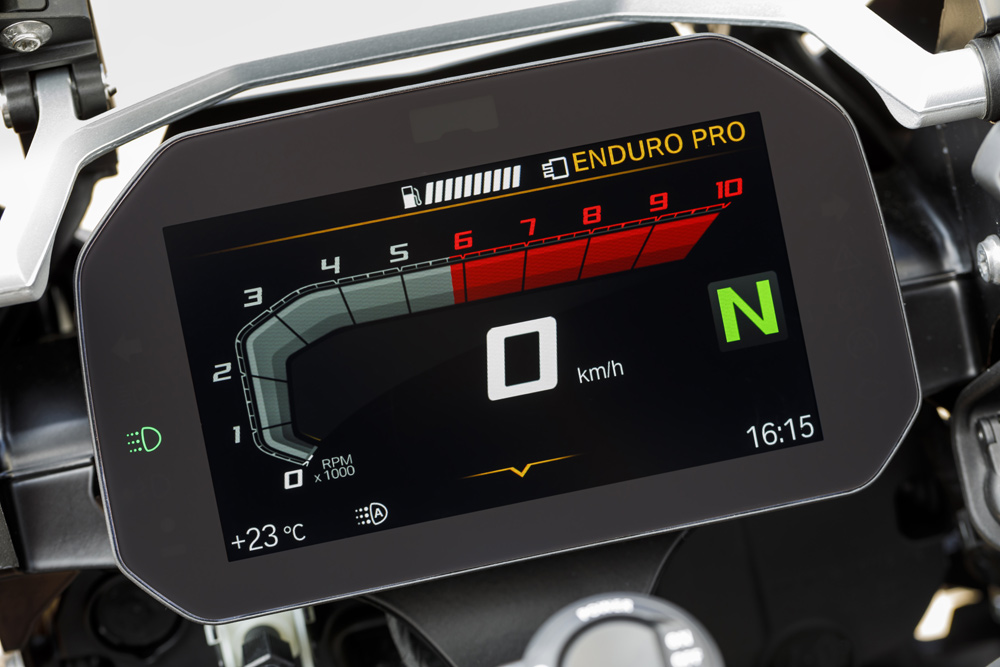
This has a super-legible digital speedo in its center with the gear selected reading on its right and almost as large, plus the BMW Motorrad Connected App can be downloaded free of charge from the Google and Apple app stores to offer an arrow-based basic navigation system directly via the TFT screen, so there’s theoretically no need to carry a Garmin or Tom Tom. With an active Bluetooth connection to any standard smartphone, you can also listen to music or take phone calls along the way.
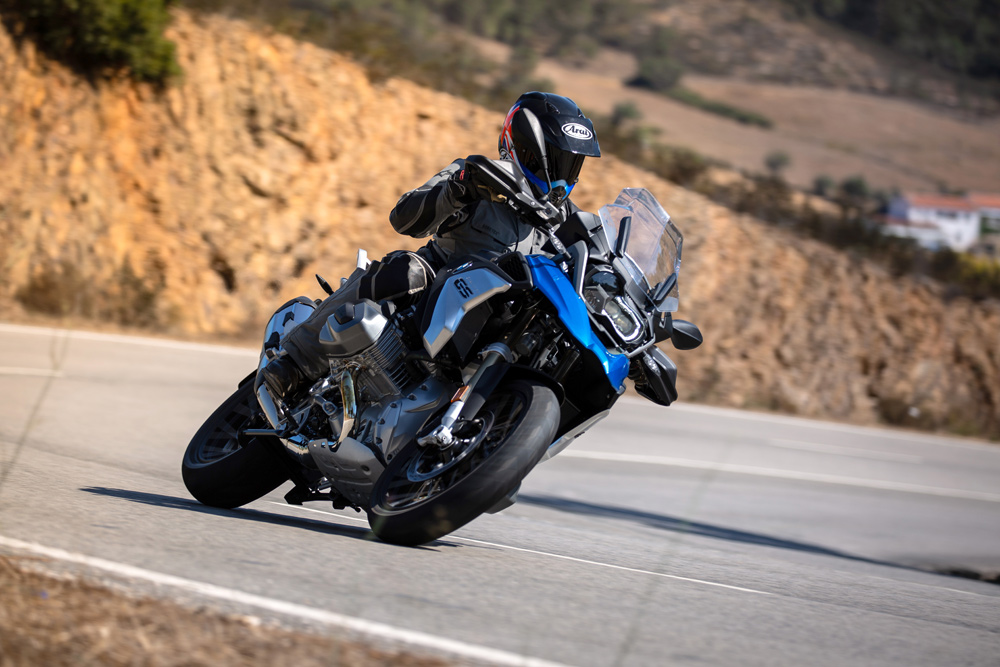
But otherwise the styling, the stock seating offering a choice between 33.5 inches and 34.3 inches in height (though there are options available as low as 31.5 inches and as high as 35.4 inches) and even the suspension are similar in appearance to the outgoing R1200GS.
Engine running, you’ll notice a deeper tone to the trademark drone of the 180º Boxer twin’s 2-1 exhaust, a new design now made from stainless steel. Moreover, the engine has noticeably less mechanical noise than the R1200, which turns out to be thanks partly to a switch to quieter toothed cam chains from the previous roller ones, and a new design of fuel injector needle for the Bosch EFI, which eliminates the clicking sound you always heard previously at low speeds while the engine was running.
However, the best is yet to come, for within the first mile of riding the new GS in rush hour traffic, you realize immediately how smooth and torquey the ShiftCam motor is. It’s super-responsive without being snatchy, yet unbelievably flexible and forgiving to ride—it takes almost any gear you throw at it, pulling cleanly away in top gear wide open from just over 2000 rpm with no transmission snatch at all.
Not that using the smooth-shifting six-speed shaft-drive transmission is at all onerous, because the hydraulically operated eight-plate slipper clutch now fitted as standard has a light lever action that makes riding the R1250GS in traffic not at all tiring for your left hand, and the shift action of the gearbox is precise and smooth. It doesn’t seem like a shaft-drive transmission in use, with not a trace of a clunk to be heard. That’s perhaps because the gearbox and clutch are now integrated into the engine crankcase, rather than in a separate bolted on housing as before. BMW says this not only helps save both space and weight, but that they’ve also improved the way in which the new Boxer engine shifts gear—and I definitely noticed that.
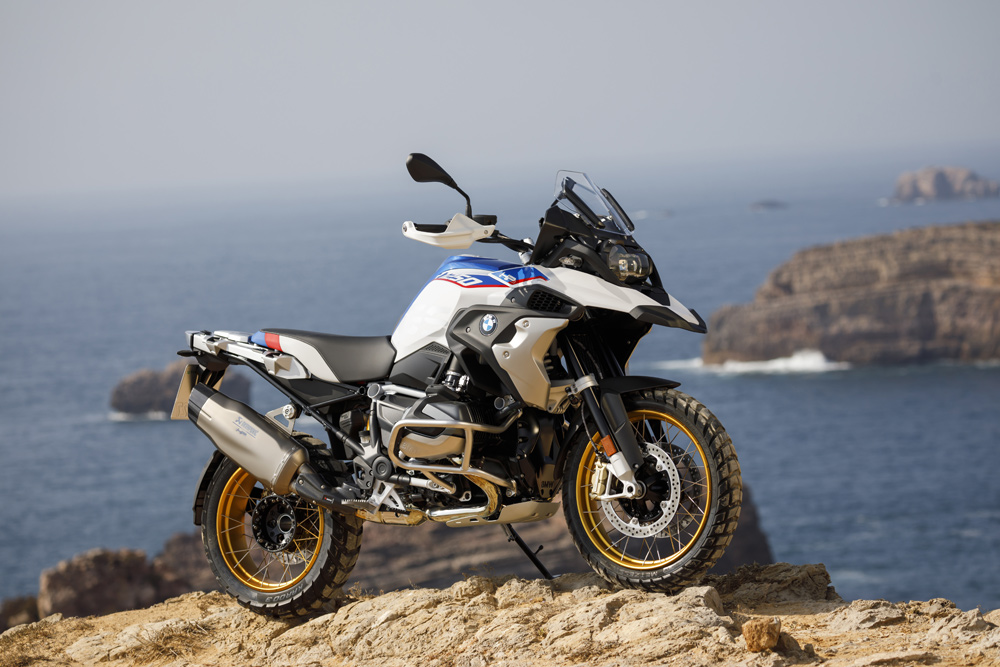
But it’s the new BMW’s smooth yet muscular throttle response that’s most impressive, thanks to the ultra-flat torque curve which sees at least 110Nm—i.e. better than three-quarters of the 143Nm peak torque figure—available from just 2000 revs upwards, all the way to its 8250 rpm redline. This uber-Boxer engine’s happy zone is between 2500 rpm and the point at which peak torque figure is delivered at 6250 rpm, and this makes holding fourth gear for miles on end along switchback hillside roads very much an approved option.
Okay, occasionally you have to drop down a gear or even two for a really tight turn, but the engine is so remarkably flexible that there simply isn’t the need to use the sweet-shifting gearbox nearly as much as before. I’m sure this is one reason for the claimed improvement in fuel consumption—you find yourself using a gear higher most of the time compared to the R1200GS, with consequently lower engine speeds. But try as I might I couldn’t detect the transition point for the ShiftCam switch from partial-load to full-load cam profiles, or vice versa.
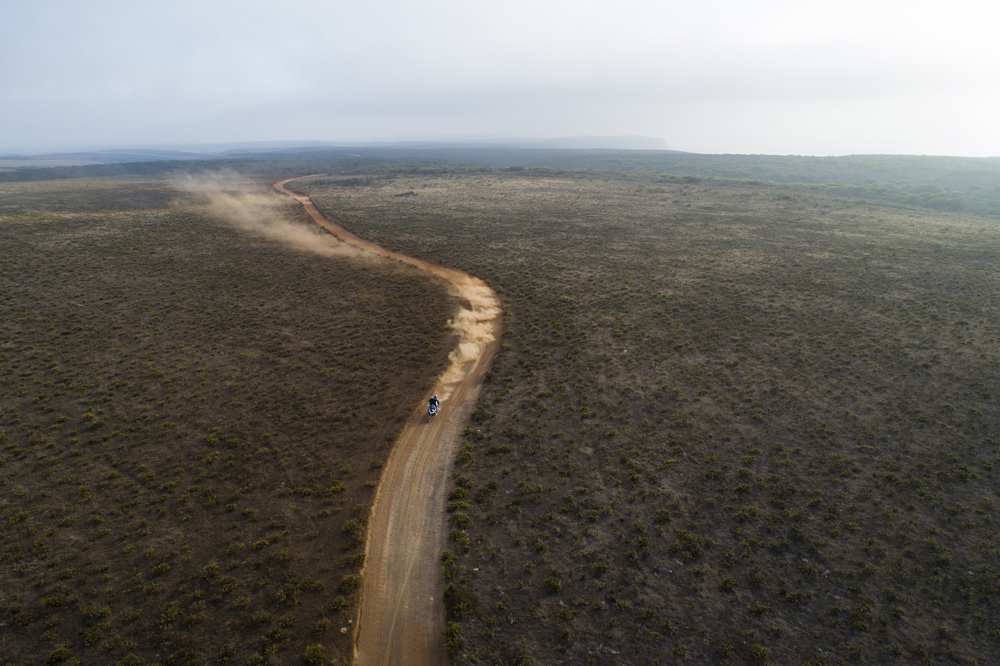
For when you decide to motor a little harder, the R1250GS is ready to rock. Wind the 52mm diameter throttle butterflies wide open, and the BMW leaps forward with surprising agility and definite purpose, accompanied by a muted rumble from that good-sounding exhaust. In no time at all you’re doing the ton, aka 99 mph with the engine running at 6000 rpm.
Thanks to the counterbalancer fitted to the engine to iron out all the vibes that used to be found with the R1150GS of 15 years ago, this thoroughly modern Boxer twin is completely devoid of vibration at any engine speed. A comfortable cruising speed of 80 mph sees the engine turning over just halfway to redline at 4300 rpm, and at such speeds this is a very capable and relaxing ride, even more than its predecessors already were, thanks to the increased rideability of the new, bigger engine. Yes, that R-word again, but it’s what the R1250GS is all about, thanks to the 14% overall increase in all-important torque.
Extra power is always nice to have—provided it’s delivered in a usable way, as here—but that isn’t what governs your enjoyment in everyday riding. Torque is what does that, and it’s clear that Klauer and his team understand that very well, for the new GS engine is a tribute to that. There are two riding modes available—Road and Rain—plus Hill Start Control.
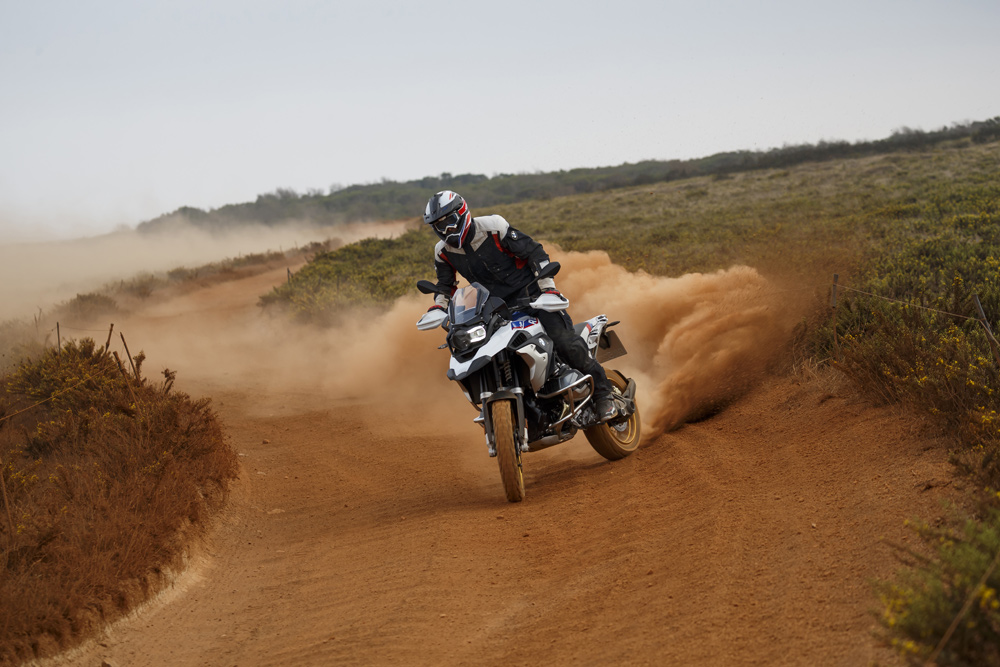
While the redesigned Boxer twin engine is clearly the star of the show on this new Beemer, that’s not to say BMW engineers haven’t paid any attention to the running gear, because the same sense of refinement that’s present in the sparkling new engine is repeated here. The ultra-compliant Sachs suspension works as well as ever. The new GS brakes work very well, too.
Curb weight has increased by 11 pounds over the R1200GS to 549 pounds, including a full 5.2-gallon fuel load.
Off-road the new flat-twin BMW is still not as light and confidence inspiring in tight sections as a V-twin KTM 1090R Adventure, but the engine’s extra grunt and controllable throttle response makes the GS a great dirt roads bike. It has a standing-up riding position that feels natural, and optional Enduro Pro electronics on the dual purpose HP version I was let loose on off-road for a while, fitted with wire wheels, long travel suspension and Metzeler Karoo knobby tires offered off-road-tailored traction control, ABS and suspension settings.
The street-only version had its cast aluminum wheels shod with Bridgestone’s new Battlax Adventure A41 rubber rather than the Metzelers I was expecting, and I must admit I was pretty impressed by them. The Telelever front suspension behaved faultlessly throughout my ride, both on loose gravel surfaces and tarmac roads alike—ride quality is high whether the road surface is bumpy or smooth.
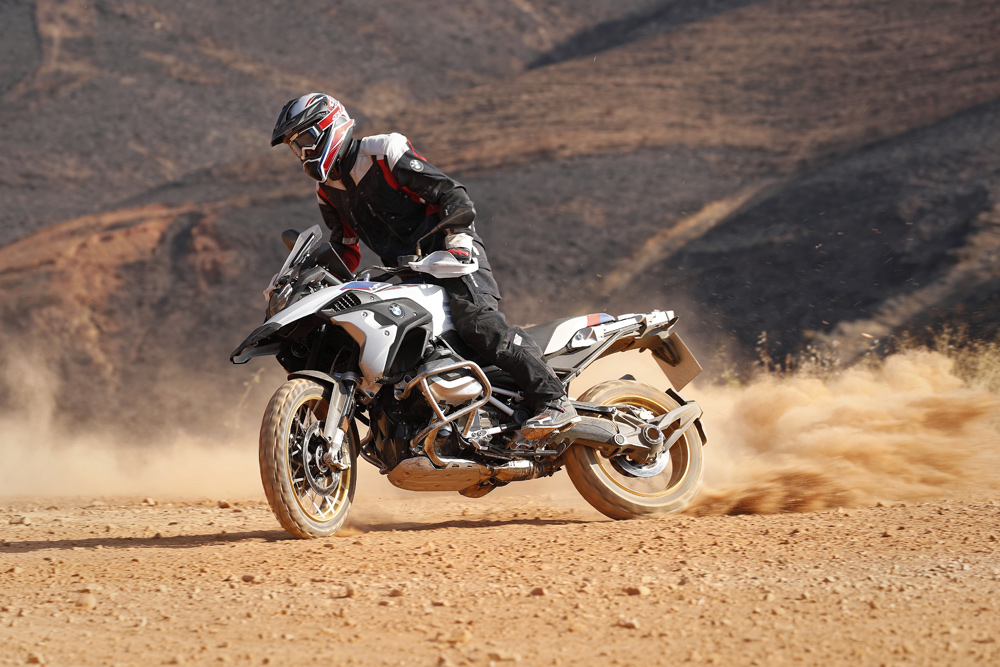
The new BMW is available in two colors, Blackstorm metallic and Cosmic Blue metallic, the base BMW R1250GS is pretty well priced, although most buyers will do what they’ve always done, and tick heaps of boxes to add optional packs covering performance and electronics, and various items of extra equipment. They’ll add thousands to the price perfectly happily because they’ll know that in exchange for doing so they’ll be riding the latest generation version of one of – if not THE – most capable all-round motorcycles money can buy.
Those up-front choices will not only considerably enhance the owning experience, but also make their R1250GS a better buy when it’s time to sell it on—or more likely trade it for the same again, only newer. And in the meantime they’ll have enjoyed owning and riding the new and very definitely improved latest version of the most popular premium motorcycle in the world today—as it was last year, and the year before that, and….
Some things never change!
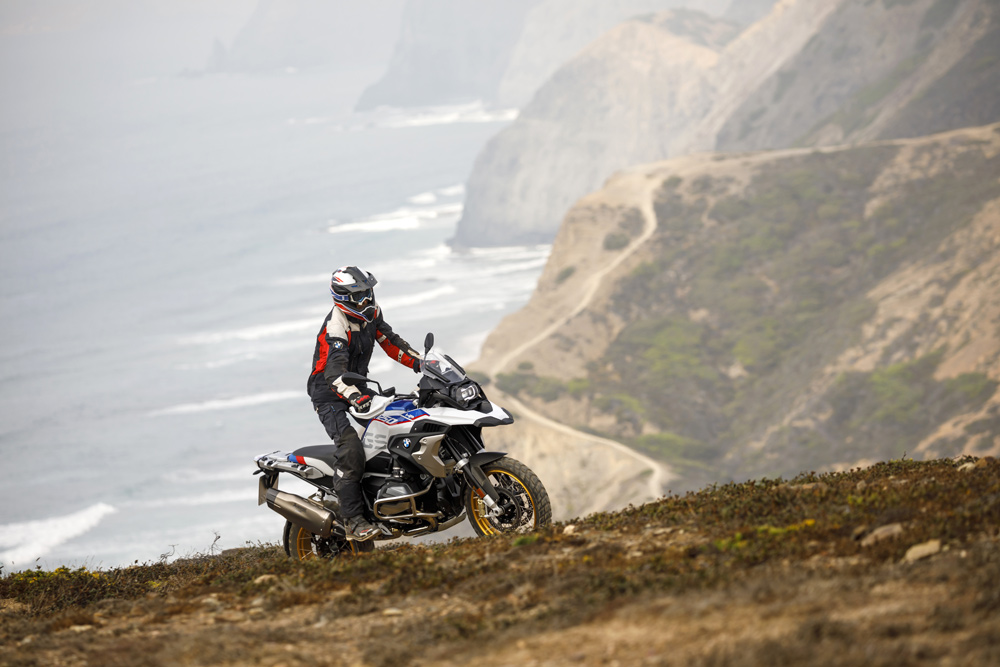
Shiftcam Technology Explained
The drive of BMW Motorrad’s team of engineers led by Ing. Norbert Klauer, its Head of Drive Train Development, to produce increased power and torque across the entire rev range of the new R1250GS engine, as well as enhanced rideability and greater refinement, coupled with reduced fuel consumption and emission levels, has resulted in the development of its innovative ShiftCam Technology—the first time that a variable valve control system has ever been fitted to a BMW motorcycle.
Although Ing. Klauer joined BMW Motorrad from its parent company’s automobile division only five years ago, he insists that this all-new system owes nothing to the Vanos variable valve timing technology developed 25 years ago for use on BMW cars, nor the Valvetronic variable valve lift system introduced in 2001, both of which were considered too bulky for motorcycle use. Instead, the R1250GS engine’s cylinder heads feature the all-new, highly innovative ShiftCam system, which combines both variable valve timing and differential valve lift, all in the same package, as a means of optimizing cam timing and duration for what you’re asking the engine to do. For part-throttle openings, or lower down in the rev range, the cam has a shorter lift and reduced duration, meaning the inlet valves are open less. But ask for more throttle or higher revs and the cam shifts sideways, bringing into play a higher lift, longer duration cam lobe, more suited to outright performance.
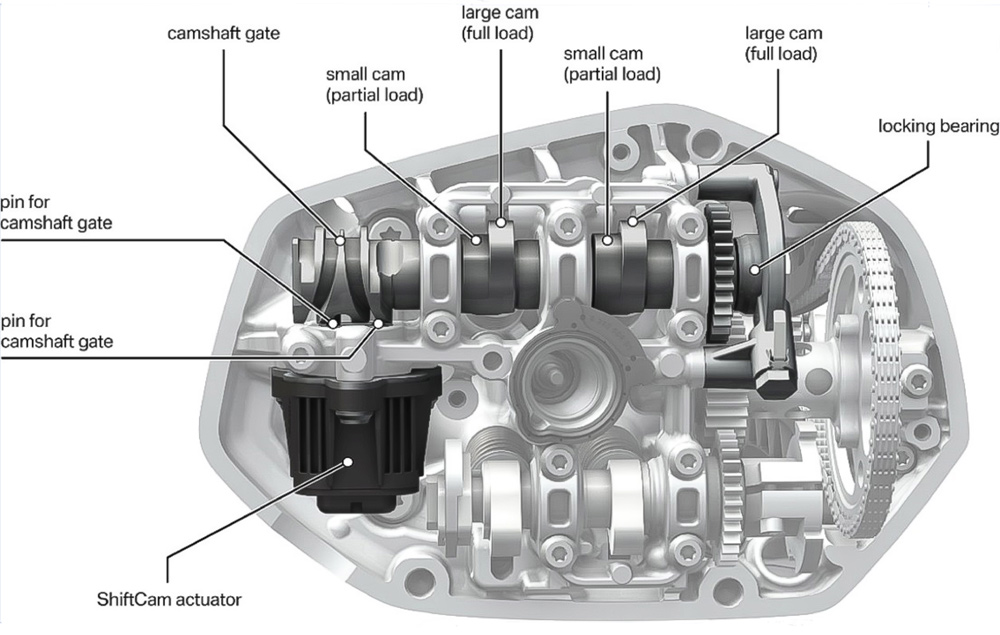
This is achieved by having the inlet camshaft of each cylinder incorporating two different cam profiles mounted side by side on the same shaft. One of these is a partial-load cam, which has been configured to deliver improved fuel consumption and refinement at part-throttle. The other is a full-load cam designed for enhanced output via more aggressive throttle openings, which delivers longer duration inlet valve openings. By means of an axial shift from side to side of each inlet camshaft, the paired inlet valves on each cylinder are activated via their finger followers by either the partial-load or the full-load cam, depending on engine rpm, gear selected, and throttle load.
As the throttle opens wider via the throttle-grip, the electronic actuator lifts a pin to lock into the inlet camshaft gate. The rotation of the camshaft then permits the pin to draw the camshaft sideways, to bring the more aggressive longer duration cam lobes into line with the valves. When the throttle is closed, the camshaft is pulled back across the cylinder head, and onto the less aggressive smaller profile cam employed for normal use. Either way, the change is practically instantaneous, taking just FIVE milliseconds to accomplish. That’s less than the blink of an eye.
Additionally, the variable configuration of the cam geometry also enables a variation in the inlet valves’ stroke. While the full-load cam provides maximum valve stroke, the partial-load cam delivers reduced stroke. There is also a phased differential opening between the left and right-hand inlet valves in each cylinder, in terms of both stroke and angular position. This phased shift means that the two inlet valves are opened a differential amount in terms of lift—i.e. one more than the other—and on a time-staggered basis. This helps create additional swirl for the incoming charge of air and fuel, and thus greater agitation of the mixture as it flows into the combustion chamber. This results in both improved combustion—so, a bigger bang—as well as a more complete burning of the fuel, thus ensuring reduced emissions and a claimed up to four percent lower fuel consumption versus the smaller capacity, less powerful R1200GS.CN

| SPECIFICATIONS | 2019 BMW R1250GS ($21,400) |
| ENGINE: | Air-cooled, 4-stroke, 8-valve boxer twin |
| DISPLACEMENT: | 1254cc |
| BORE X STROKE: | 102.5 x 76mm |
| COMPRESSION RATIO: | 12.5:1 |
| TRANSMISSION: | 6-speed |
| CLUTCH: | Wet, with anti-hopping function, hydraulic |
| FRAME: | Two-section, load-bearing engine, bolt-on subframe |
| FRONT SUSPENSION: | BMW Motorrad Telelever |
| REAR SUSPENSION: | Cast aluminum single-sided swingarm with BMW Motorrad Paralever, WAD spring strut, fully adjustable |
| FRONT WHEEL TRAVEL: | 7.5 in. |
| REAR WHEEL TRAVEL: | 7.9 in. |
| FRONT BRAKE: | 350mm twin floating discs, 4-piston radial, ABS |
| REAR BRAKE: | 276mm single disc, 2-piston floating caliper, ABS |
| FRONT WHEEL: | 3.00 x 19 in. |
| REAR WHEEL: | 4.50 x 17 in. |
| FRONT TIRE: | 120/70 x 19 in. |
| REAR TIRE: | 170/60 x 17 in. |
| WHEELBASE: | 60 in. |
| SEAT HEIGHT: | 33.5/34.3 in. |
| WEIGHT (claimed): | 615 lbs. |
| FUEL CAPACITY: | 5.3 gal. |
Click here to read this in the Cycle News Digital Edition Magazine.
Click here for more BMW motorcycle reviews and news.
Click here for the latest Cycle News Dual Sport motorcycle reviews and news.
